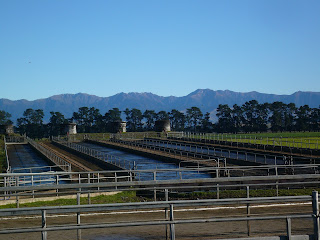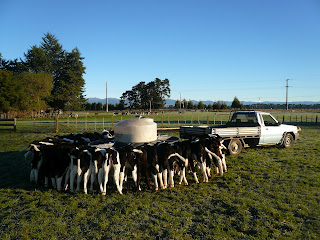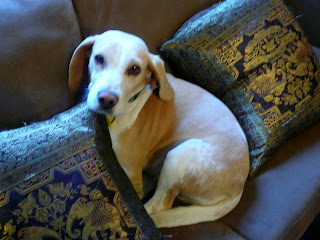In New Zealand, milk production per cow is measured in milk
solids. One milk solid is the total fat and protein content of the milk
produced by one cow in one lactation. A common measurement of milk production
efficiency is the kilograms of milk solids produced per hectare of land
(kgMS/ha). A simple pasture based system produces >1000 kgMS/ha. BEL Group’s
goal is to produce 1050 – 1200 kgMS/ha over all farms, with Ashton producing
1530 kgMS/ha consistently. To achieve these levels of milk production, a farm
must be achieving a minimum feed conversion of 16 kgDM feed:1 kgMS
produced.
As of June 1, 2012, BEL Group produced 2.97 million kgMS
from 2300 ha.
The two large, upright bulk tanks at Ashton
During peak milk production, Fonterra has to pick up 2x per day!
According to the BEL Group handbook, days in milk + cows +
feed management = profitable milk solids production. Because timing is critical
to manage milk production with a pasture-based dairy system, BEL Group has
specific on-farm targets for:
- Calving date
- Mean calving date is planned for 7 weeks prior to expected pasture growth equal to herd demand
- Mean calving date on standard system = August 8th
- Target day sin milk prior to December 31st = 145 days
- Milk production before December 31s
- Fundamental target to monitor
- Producing milk before Christmas reduces the farm’s risk of exposure to a dry summer and/or autumn
- Annual milk production
- BEL Group requires 1000 kgMS/ha and 330 kgMS/cow
Another large difference between the US and New Zealand is
the trend for farms to move towards milking cows only one time per day instead
of two, whereas the trend in the US is to move from milking 2x to 3x. Ashton
milks its cows two times per day, except the lame cows, which are milked only
one time per day. The amount of pasture available drives the milk production
for all cows, especially in areas that are drier in the summer. It makes sense
for these farms to milk only one time per day since it is more labor efficient
and less demanding on the cows when there is not enough pasture.
"Cow shed" (AKA milking parlor) at Ashton
Saturday, June 16, 2012
I could hear the rain outside this morning even before I got
out of bed at 6 AM. I drove the 4-wheeler to the farm with Josh at 7, thankful
for the raincoat and waterproof bibs I received from Bel Group when I arrived.
According to Josh, providing wet/warm weather gear for employees is required by
law in New Zealand…not a bad idea!
First, Josh had me take the 4-wheeler out to pasture 68 where
the dry cows are kept that Josh and I shifted yesterday. I was supposed to
shift the fence reel another 40 paces and let the cows have that for the day.
When I got to the pasture I realized something was wrong and that the cows had
gotten through the reel I had set up yesterday and were now working towards
eating the rest of the pasture! I rode off to get Josh and when I told him he chuckled
a little but didn’t seem too surprised. We drove back to the pasture and I set
up a new fence reel only 20 paces ahead of the one the cows got through while
Josh corralled the cows for me. Once he left I set up another reel of fence
line 50 paces ahead of the one I had just set up, as a safety line in case the
cows got through again.
Dry cows on pasture after putting up another fence reel
Next I went to the crop of forage rape that Herd 2 cows eat
from every morning after milking and put up another fence 8 paces in front of
the current fence.
After shifting all of the cows, I took grain to the calves
that had just been weaned. They still were not very happy about not getting
milk. Next I fed the two mobs of calves still on milk and was finished working
for the day by 11 AM.
Tonight Becs’ mom and dad came over for supper and to watch
the rugby match between New Zealand’s All Blacks and Ireland. I had no idea
what was going on but it was an impressive game to watch, with the ball and its
players always moving. The All Blacks beat Ireland 21 to 19 and I am off to
bed!
Sunday, June 17, 2012
This morning was early and cold. I started milking at 5:30
for Rhoxus so he could draft cows for breeding today. Once Rav arrived at 7:30
I was able to do the rest of my chores. First, I shifted the Herd 2 cows onto
the crop of forage rape and then took the 4-wheeler to shift the dry cows in
pasture 68. Luckily, the cows had not gotten over the fence I put up yesterday.
After putting up another fence line 40 paces in front of them, I let the cows
onto their fresh grass for the day. My next job was to feed the weaned calves
their grain and then feed the milk calves. By 11 AM I was done for the day!
Herd 2 on the feedpad this morning before milking.
Next Friday, Josh and Becs are going to Wellington to see a
University friend who has an awards banquet. We will be staying in the center
of the capital city so I will be able to do some sight-seeing while I am there!
Hopefully we will get there at a good time Saturday so I can ride the cable car
and visit the Te Papa Museum of New Zealand.
Monday, June 18, 2012
It has already been 3 weeks since I arrived!
This morning Josh and I rode to the farm together in the
white ute at 7 AM. A hard frost had settled overnight so there was not much we
could do with the pastures. If grass that has frost on it gets stepped on or
run over, it can break the blades of grass and damage the so they will not grow
back well. Usually the frost lifts within 10 minutes of the sun coming up, but
there were so many clouds that the frost did not lift until about 9:30 AM.
Sunrise on this frosty morning
Once the frost was gone I was able to shift the dry cows and
let the Herd 2 cows onto the crop of forage rape for the day and shift the
fence reels. Next I fed the weaned calves their grain and the 2 mobs of milk
calves. By the time I finished it was time for lunch.
I went back to the farm at 2 PM and milked the afternoon
milking because one of the scheduled milkers was gone. After a long day of work
I came back to the house, at supper, and am going to bed.
Tuesday, June 19, 2012
I got to the farm at 7:30 this morning and did my usual
chores – shifted dry cows and Herd 2 cows, fed grain to the weaned calves, and
fed the 2 mobs of milk calves.
It rained quite a bit last night and the areas of shade in the pasture where the milk calves are were pretty muddy. After I finished feeding milk to the 2nd mob of calves I tried to pull away, but the blue ute I was driving would not move. Once I figured out my back tires were spinning I tried to put it in reverse. After that didn’t work I unhooked the calf feeder but still could not get unstuck. Of course I was at the pasture down the road from the farm and do not have a cell phone. Luckily a man driving a big sprayer truck was nearby so I recruited his help. He was super nice and even had a tow rope to pull me out of the ruts my back tires had made.
Sunrise over the dry cows I shifted this morning
It rained quite a bit last night and the areas of shade in the pasture where the milk calves are were pretty muddy. After I finished feeding milk to the 2nd mob of calves I tried to pull away, but the blue ute I was driving would not move. Once I figured out my back tires were spinning I tried to put it in reverse. After that didn’t work I unhooked the calf feeder but still could not get unstuck. Of course I was at the pasture down the road from the farm and do not have a cell phone. Luckily a man driving a big sprayer truck was nearby so I recruited his help. He was super nice and even had a tow rope to pull me out of the ruts my back tires had made.
By the time I made it back to the farm it was 10:30 AM, a
lot later than I should have been. After washing the calf feeder I helped clean
up after milking by hosing down the exit races from the holding area of the
parlor as well as the front of the feed pad. Then it was time for lunch.
I drove back to the farm for the weekly farm meeting at 1:45 PM and then stayed for the afternoon milking to draft out late calving cows from Herds 1
and 2, and put them into Herd 3 at the end of milking. Once I was done it
was time for home.
Wednesday, June 20, 2012
Once again this morning I was at the farm at 7:30 AM. I started
by shifting the dry cows and Herd 2 cows. I used the 4-wheeler to tow the calf
feeder to feed calves this morning and did not get stuck! Herd 3 cows were
milked late this morning because of a malfunction with the rotary parlor. It
didn’t take long for the repair team to show up and they were done milking only
about an hour behind schedule.
Herd 3 cows in the holding area waiting to be milked
At 12:30 PM I came back to the farm from lunch and drove the
Herd 1 cows to the feedpad to eat their mixed ration before the afternoon
milking. After that I went to the cow chute where the LIC AB technician was
breeding today’s cows. He asked if I knew how to breed and when I said yes, he
told me to grab a sleeve and I helped him finish by breeding 4 cows.
The rest of the afternoon Sam and I worked on some projects.
First, we combined the 2 pastures of weaned calves I have been feeding grain.
Once the calves saw me driving the blue ute, they all followed me to the new
pasture, even though I wasn’t towing the milk feeder. Our next job was to feed
the small group of lame cows a bucket of corn silage. Sam loaded the feed into
the wagon and then showed me how to drive the John Deere 6310. After that we
worked on fixing the underground broken water line next to the parlor. The
jagged ends of both water lines were exposed so we needed to dig them out and
saw them off clean. Next we found some extra pipe, fitted connectors to both ends, and placed this pipe
between the broken ends. The next test will be to turn the water on and hope
there are no leaks!
Thursday, June 21, 2012
This morning I got to the farm at 7:30 and shifted the Herd
2 cows onto the crop right away. After that was done Sam, Rav, and I went to
the herd of dry cows I have been shifting and took 100 of those cows out of the
170. We drove these 100 cows down Burnside Road (the road Ashton is on), took a
left onto Ashcott road (the road I live on) and then took another quick left
into a new pasture of fresh grass. The pasture was already sectioned off into
smaller sections with a fence reel, so once we got the cows into the
appropriate paddock, the job was done. One the way back to the farm Sam let me
drive his 2-wheeler (dirtbike), which all employees at Ashton drive.
After an uneventful first dirtbike ride back to the farm, I
tail-painted all of the AB cows for the day and then fed the milk calves. Then
it was time for lunch.
I returned to the farm after lunch and drove the Herd 1 cows off the crop and onto the feedpad. Next I treated a sick calf
in one of the milk mobs. My next job was to take a lame cow from pasture 64 and
move her to pasture 49 with a small group of cows from pasture 48 for the vet
to look at. It was slow moving the lame cow, but I had the 2-wheeler so it was
good practice. Once I got the cow to 49, I set up a reel of fence in the corner
of 49 with the water tank. Then I drove the 8 cows from 48 into the paddock of
49 I set up. The job was perfect practice for riding a 2-wheeler and I was also
reminded that electric fences and dirt bikes are not a good combination. The
little incident I had made the job take about an hour longer than it should
have, but after getting the bike out of the tangle of fence line all by myself
(after a few shocks and choice words), I felt very resourceful (especially
since I did not have a cell phone, again).
Rainbow over the farm I could see from the pasture
Once I made it back to the parlor Becs had one more job for
me. I needed to draft out all of the cows eligible for breeding (the ones with
tail paint) out of Herd 3, divide them in half, and put a group in Herds 1 and
2. These are early lactation cows that calved in the autumn (March – May) so by
putting them in Herds 1 and 2 they will get the extra energy they need from the
crop. Now Herd 3 is made up of late lactation, pregnant cows that will be dried
off in the middle of July because they will calve later during the spring in
September.
Tomorrow Josh, Becs, and I are driving to Josh’s parents’
home in Featherston for the night and Saturday night we will stay in the capital city of
Wellington. I spent the rest of the night packing and planning out what I
wanted to see while at the capital.
Friday,
June 22, 2012
This morning I had to go to the farm to feed the milk
calves. I got there at 8 AM and was done by 9:30. Becs and I went back to the
house together and by 11 AM her, Josh, and I left for my first weekend away
since arriving. We drove about an hour before stopping for lunch at the
original Tui Brewery, the iconic beer of New Zealand, in Pahiatua. After lunch I got my own Tui mug to bring home that came with
my beer!
My Tui Brewery Mug
We got back on the road and drove about a ½ hour to
Masterton, where Josh and Becs had a meeting at 2 PM. They dropped me off on
main street and I had about time to explore the main drag of Masterton and visit
gift shops.
At 3 PM Josh and Becs picked me up and we drove the rest of
the way to Josh’s parents’ (Alec and Julie) house in the small town of Featherston. The rest of
the evening was spent visiting and talking with Josh’s parents about everything
from dairying in New Zealand and the US to life in general. Josh’s parents own
and operate a 650-sow piggery (hog farm), with about 12,000 hogs total, as well as a 400-cow
dairy. Unlike Ashton, they only have spring calving (which is much more
common). Josh’s dad has been to Iowa to look at some of the large-scale pig
operations there, so he has a sense of the large-scale hog operations in the
US. After the night was over, it became apparent that animal welfare is
becoming a large concern for dairy farmers in both the US and New Zealand. The
focus differs between countries. In New Zealand, the general public sees it as
good practice to let the cows be outside instead of inside. In the US, cows are
kept inside most of the time to avoid weather extremes like frostbitten teats
or heat exhaustion.









































